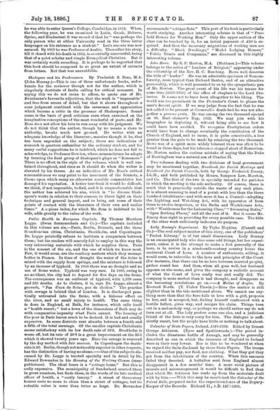Public Health in European Capitals. By Thomas Morrison Legge. (Swan
Sonnenschein and Co.)—The capitals included in this volume are six,—Paris, Berlin, Brussels, and the three Scandinavian cities, Christiania, Stockholm, and Copenhagen. Dr. Legge pointedly refuses to Institute a comparison between them; but his readers will scarcely fail to employ in this way the very interesting materials with which he supplies them. Paris is the nearest of the six, and the one of which we know most. Few, it would seem, are the sanitary matters which they manage better in France. In time of drought the water of the Seine is mixed with the supply from springs, and the mixture is followed by an increase of typhoid. In 1888 there was no drought and no use of Seine water. Typhoid was very rare. In 1889, owing to an accident, the city had to depend for five days on the Seine. The consequence was an outbreak of typhoid, with 1,570 cases and 220 deaths. As to cholera, it is, says Dr. Legge, almost a proverb, "Pas d'eau de Seine, pas de chol6ra." The practice with sewage is behind that of London. It is discharged prac- tically untreated into the Seine, with a hideous effect on the river, and no small injury to health. The same thing is done in England, at Bath, for instance, which calls itself a "health resort;" but a town of the dimensions of Bath may do with comparative impunity what Paris cannot. The housing of the poor in Paris leaves much to be desired. It is bad and cruelly expensive. In some districts rent absorbs between a fourth and a fifth of the total earnings. Of the smaller capitals Christiania seems satisfactory with its low death rate of 191. Stockholm is worse off, but its rate of 20.8 is a great improvement on the 351 which it showed twenty years ago. Here the sewage is removed by the day method with fair success. In Copenhagen the death- rate is 20. Berlin, though not noticeably superior in other respects, has the distinction of having no slums.—One of the subjects dis- cussed by Dr. Legge is treated specially and in detail by Dr. Edward Bowmaker in his Housing of the Working Classes (same publishers). The ideal home is a "cottage home." But this is sadly expensive. The municipality of Sunderland erected them in great numbers, but finds them, in the words of its late medical officer of health, a "costly luxury." A street of three-story houses costs no more to clean than a street of cottages, but its rateable value is more than twice as large. Dr. Bowmaker
recommends "cottage-flats." This part of his book is particularly worth studying. Another interesting scheme is that of " Free- hold Houses for Working Men." Only the upper section of the class can be touched by it, for an initial payment of 420 is re- quired. And then the necessary migrations of working men are a difficulty. "Block Dwellings," "Model Lodging Houses," "Public Trusts and Companies," are discussed in this highly interesting volume.


































 Previous page
Previous page